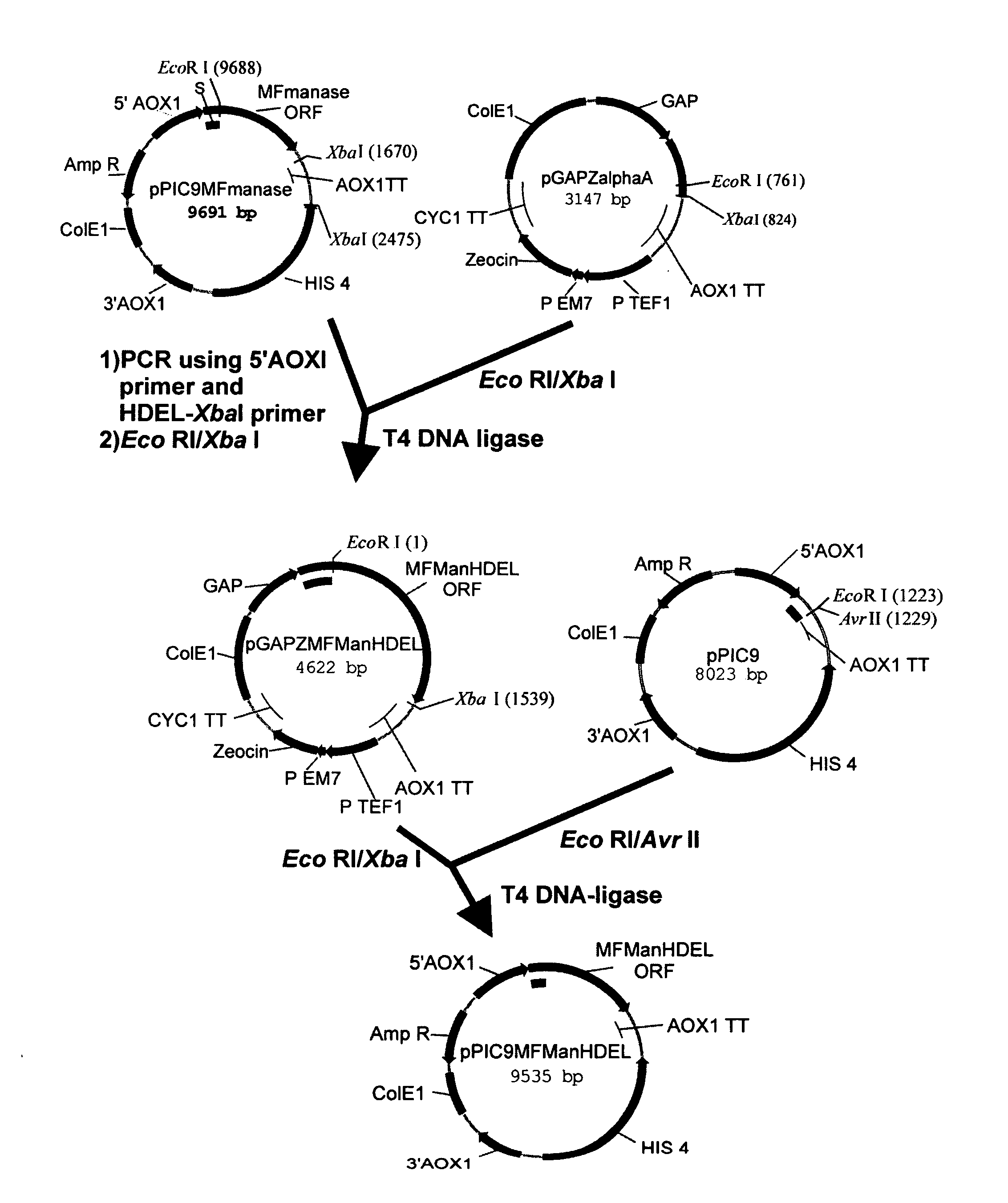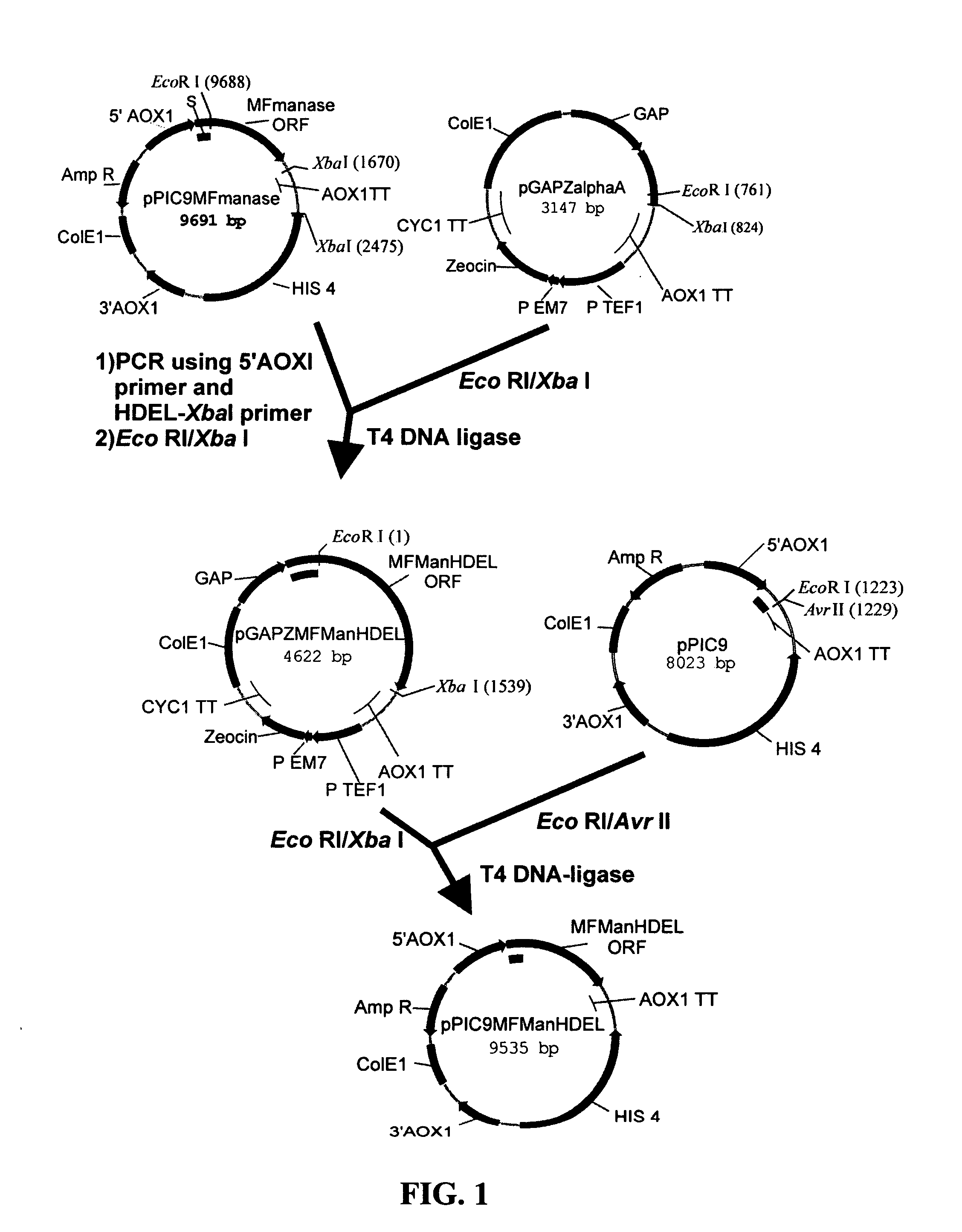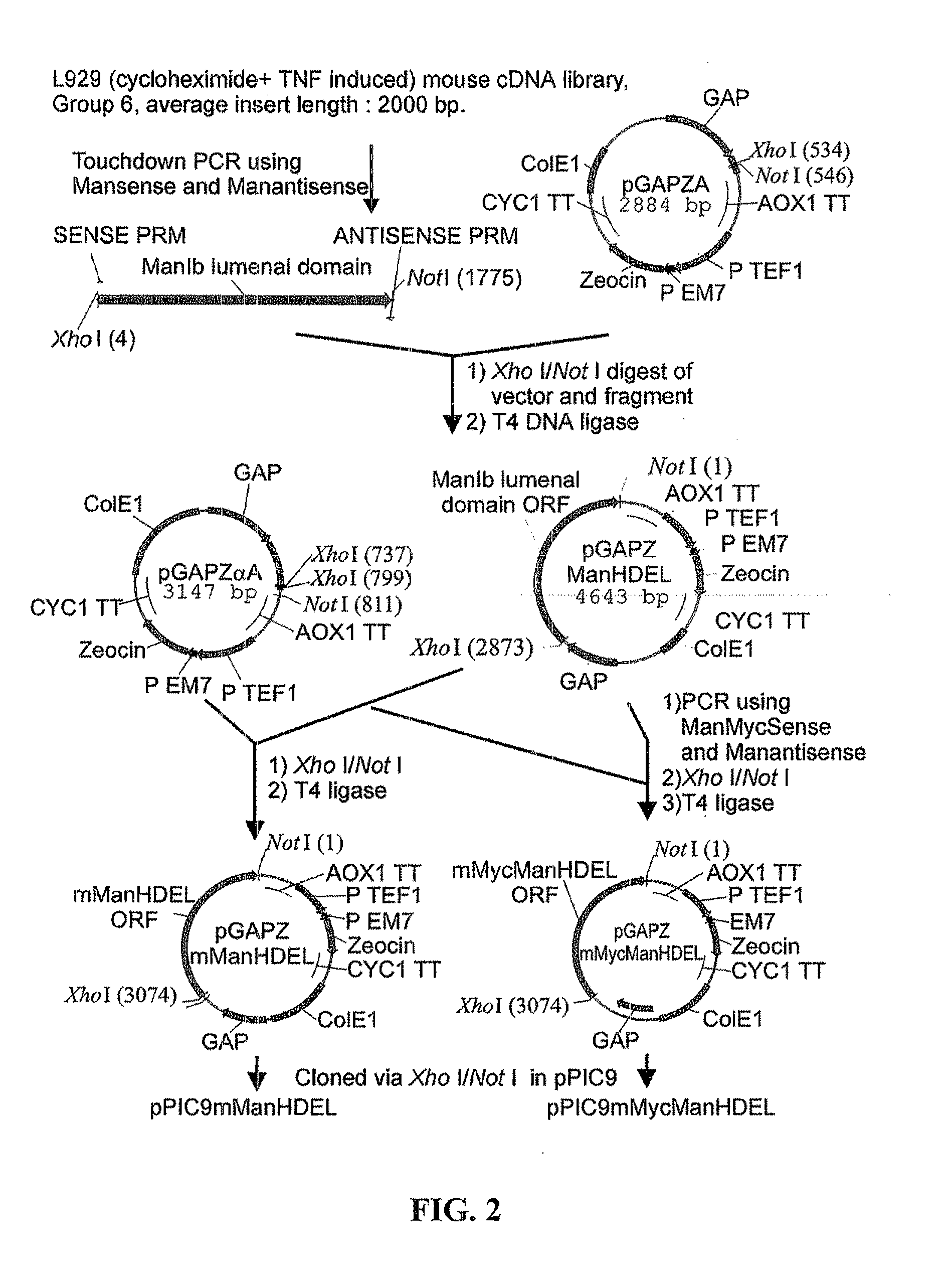Protein glycosylation modification in methylotrophic yeast
a technology of methylotrophic yeast and glycosylation modification, which is applied in the direction of peptides/protein ingredients, peptides, bulk chemical production, etc., can solve the problems of affecting the production and medical applications of some therapeutic glycoproteins, affecting the immunogenicity of outer chain glycosylation, etc., to achieve the reduction of glycosylation on heterologous proteins expressed from these previously geneti
- Summary
- Abstract
- Description
- Claims
- Application Information
AI Technical Summary
Benefits of technology
Problems solved by technology
Method used
Image
Examples
example 2
Co-Expression of Mannosidase-HDEL with Recombinant Glycoproteins
[0142]Co-Expression of Mannosidase-HDEL with the Trypanosoma cruzi trans-Sialidase
[0143]The cloning of a Trypanosoma cruzi trans-sialidase gene coding for an active trans-sialidase member without the C-terminal repeat domain has been described by Laroy et al. (Protein Expression and Purification 20: 389, 2000) which is incorporated herein by reference. The sequence of this Trypanosoma cruzi trans-sialidase gene is available through NCBI Genbank under the Accession No. AJ276679. For expression in P. pastoris, the entire gene was cloned in pHILD2 (Invitrogen, San Diego, Calif.), creating pHILD2-TS. To allow better secretion, pPIC9-TS was created in which trans-sialidase was linked to the prepro secretion signal of the yeast α-mating factor. Plasmids pPIC9-TSE and pCAGGS-prepro-TSE were created where the epitope E-tag was added to the C-terminal of the trans-sialidase to allow easy detection and purification. The construct...
example 3
Inactivation of the Pichia Och1 Gene
[0152]A Pichia pastoris sequence was found in the GenBank under Accession No. E12456 and was described in Japanese Patent Application No. 07145005, incorporated herein by reference. This sequence shows all typical features of an α-1,6-mannosyltransferase and is most homologous to the S. cerevisiae OCH1, thus referred to herein as the Pichia pastoris Och1 gene.
[0153]First, the full ORF of the Pichia pastoris Och1 gene was PCR cloned in pUC18 to obtain plasmid pUC18pOch1. pUC18pOch1 was cut with HindIII, blunt-ended with T4 polymerase, then cut with XbaI, releasing a fragment containing the 5′ part of the Pichia pastoris Och1 gene. This fragment was ligated into the vector pBLURA IX (available from the Keck Graduate Institute, Dr. James Cregg, which had been cut with Eco RI, blunt-ended with T4 polymerase, and then cut with Nhe I. This ligation generated pBLURA5′PpPCHI, as shown in FIG. 8.
[0154]Disruption of this Pichia OCH1 gene in the Pichia genom...
example 4
Expression of Glucosidase II in Pichia pastoris
[0157]4.1 Amplification of the GLSII Alpha Subunit ORF from S. cerevisiae.
[0158]Genomic DNA was prepared from the S. cerevisiae strain INVS (α, leu2-3, 112 his3Δ1, trpl-289, ura3-52), using the Nucleon kit (Amersham). A touch-down PCR reaction was performed using this genomic DNA as template and the LA TaKaRa polymerase (ImTec Diagnostics). The sequence of the PCR primers was based on the known sequence of the S. cerevisiae GLSII ORF:
Sense primer:(SEQ ID NO: 12)5′ CCG CTC GAG ATG GTC CTT TTG AAA TGG CTC 3′ Xho IAntisense primer:(SEQ ID NO: 13)5′ CCG GGC CCA AAA ATA ACT TCC CAA TCT TCA G 3′ Apa I
4.2 Cloning of the S. cerevisiae Glucosidase II ORF into Pichia pastoris Expression Vectors.
[0159]Construction of the glucosidase II expression vectors—The PCR fragment was digested with Xho I / Apa I and ligated into the pGAPZA vector (Invitrogen), thereby placing the ORF under the transcriptional control of the GAP promoter. Using...
PUM
| Property | Measurement | Unit |
|---|---|---|
| pH | aaaaa | aaaaa |
| concentration | aaaaa | aaaaa |
| wet weight | aaaaa | aaaaa |
Abstract
Description
Claims
Application Information
 Login to View More
Login to View More - R&D
- Intellectual Property
- Life Sciences
- Materials
- Tech Scout
- Unparalleled Data Quality
- Higher Quality Content
- 60% Fewer Hallucinations
Browse by: Latest US Patents, China's latest patents, Technical Efficacy Thesaurus, Application Domain, Technology Topic, Popular Technical Reports.
© 2025 PatSnap. All rights reserved.Legal|Privacy policy|Modern Slavery Act Transparency Statement|Sitemap|About US| Contact US: help@patsnap.com



